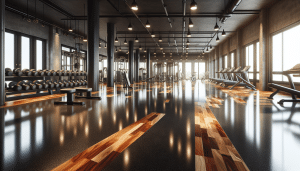School hallways, gym floors, cafeterias — they see everything. Spills, snow boots tracked in from the Wasatch, scuffed sneakers, science experiments gone sideways. That’s why Epoxy Floor coating isn’t just a nice finish; it’s a practical, everyday safeguard. Whether you’re a facilities manager, a principal, or a homeowner thinking about community rooms, this piece explains how the right floor system keeps kids safe, cuts costs, and lasts through seasons — especially here in Salt Lake City.
Contents
- 1 Why Schools need floors that do more than look pretty
- 2 Slip resistance: fewer falls, fewer worries
- 3 Durability — because budgets are real
- 4 Stain and chemical resistance — messy projects, no panic
- 5 Easy cleaning — less downtime, better hygiene
- 6 Design, wayfinding, and behavior — a bit of psychology
- 7 Installation, timing, and the unavoidable truth about downtime
- 8 What about costs? Quick math that actually helps
- 9 Local factors: Salt Lake City weather and environmental quirks
- 10 Picking materials and contractors — what to ask
- 11 Real-life touches — anecdotes that matter
- 12 How to move forward — practical next steps
- 13 Ready to make your school safer? Contact Utah Epoxy Coatings
Why Schools need floors that do more than look pretty
Let’s be honest: schools are messy. They’re loud, they’re busy, and they’re constantly in motion. A floor that chips or stains quickly becomes a liability — tripping hazards, costly repairs, and cleaning headaches. But a properly installed epoxy floor coating turns that problem on its head. It creates a seamless surface that resists wear, is easy to maintain, and actually helps prevent accidents.
Here’s the thing — durability and safety aren’t mutually exclusive. You can have both, and you don’t need to sacrifice one for the other.
Slip resistance: fewer falls, fewer worries
Falls are one of the most common injuries in schools. Slippery floors make an already chaotic environment riskier. Epoxy systems can be formulated with graded aggregates — tiny mineral particles — to increase traction. That means when a hallway looks wet from tracked-in snowmelt, the floor still grips shoes better than plain sealed concrete.
You know what? Small changes matter. A textured epoxy in a stairwell or entrance can cut slip incidents without making the surface feel rough underfoot. It’s subtle, but it matters when you’re moving 500 students between classes.
Durability — because budgets are real
Budgets get tight. Maintenance budgets get tighter. Epoxy coatings deliver a long service life compared with many alternatives. They’ll stand up to heavy foot traffic, rolling carts, and even occasional equipment drops. That means fewer repairs and less repainting — which, in the long run, saves districts money.
And yes, it’s a bit counterintuitive: spending more on a good coating often means spending less overall. That’s not a sales pitch — it’s math. A robust epoxy floor reduces lifecycle cost by minimizing repairs, reducing downtime, and stretching the interval between full replacements.
Stain and chemical resistance — messy projects, no panic
Science class spills, art supplies, cafeteria grease — schools see it all. Epoxy is resistant to many common chemicals, stains, and oils. That resistance keeps floors looking clean and helps maintain a healthier environment for students and staff.
Let me explain: when a surface repels stains, cleaning becomes faster and easier. Janitorial teams don’t need harsh scrubbing or aggressive cleaners. That saves labor and reduces exposure to strong chemicals — a win for safety and health.
Easy cleaning — less downtime, better hygiene
Seamless floors mean fewer crevices for dirt, dust, and bacteria to hide. In cafeterias and locker rooms, that’s huge. A smooth epoxy floor coating wipes down quickly with routine mopping or auto-scrubbers — tools many custodial crews already use, like Tennant or Clarke machines.
And during flu season or when concerns about airborne illness spike — yes, that happens here — quick, thorough cleaning matters. Epoxy holds up to repeated disinfection, so schools can respond fast without wrecking the finish.
Design, wayfinding, and behavior — a bit of psychology
Floors do more than carry weight. They guide behavior. Colored epoxy zones can delineate playground boundaries, bus loading areas, or quiet reading nooks. High-contrast walkways help visually impaired students and reduce confusion during crowded transitions.
Think of it like painting lanes on a road. A bright stripe says “stay here,” whereas a faded floor says, “do whatever.” Clear visual cues reduce chaos — and that can reduce incidents. Plus, modern epoxy systems can be customized with school logos, safety markings, and anti-fatigue zones in maintenance shops.
No one likes projects that interrupt the school year. The good news: many epoxy systems can be installed quickly, often during summer breaks or weekends. Yet here’s a mild contradiction — while some fast-curing epoxies let you reopen spaces within 24 to 48 hours, others need a few days to reach full strength. So timing and product choice matter.
We usually recommend coordinating the schedule with maintenance calendars. If you’ve got a gym tournament in two weeks, choose a fast-cure system (ask your contractor about Graco plural-component sprayers and fast-curing epoxy blends). But if you have a summer window, a high-performance system with longer cure time may give you superior longevity.
What about costs? Quick math that actually helps
Short answer: upfront costs vary, but epoxy often proves economical when you consider lifecycle expenses. Think of it like buying a good winter jacket. The cheap one keeps you warm for a season, the quality one lasts years and deals better with snow, wind, and wear. Schools that treat floors as a long-term investment usually see a return through lower repair and cleaning costs.
To be practical: ask for total cost of ownership numbers. Look for warranties and service plans. And if your maintenance team uses heavy equipment, factor rolling loads into the spec — that affects product choice.
Local factors: Salt Lake City weather and environmental quirks
Salt Lake City brings its own challenges. Winter means boots, salt, and grit. Spring brings those sudden warm spells that melt snow, then re-freeze. That freeze-thaw behavior stresses surfaces. Epoxy resists abrasion from grit and, when specified correctly, handles seasonal moisture without delaminating.
Also, school districts here sometimes get federal or state funding for safety upgrades. It’s worth checking whether grants can help offset the cost of higher-grade coatings. You might be surprised — many districts have tapped local improvement funds for flooring projects.
Picking materials and contractors — what to ask
Not all epoxies are created equal. Ask for these basics when you talk to vendors:
- Slip-resistance rating: What texture and coefficient of friction will the system provide?
- Cure time and return-to-service: How soon can students use the area again?
- Warranty and maintenance plan: What’s covered and for how long?
Also, ask about equipment. Contractors using plural-component sprayers (Graco, Wagner models) typically get a more consistent mix and better coverage than those pouring by hand. And don’t forget surface prep — proper shot-blasting or diamond grinding matters more than the topcoat. A beautiful finish over a poorly prepared slab will fail sooner than you’d like.
Real-life touches — anecdotes that matter
Picture a middle school gym one winter: muddy boots, P.E. classes back-to-back, and noon cleanup crews racing the clock. After a textured epoxy install, janitors reported faster cleanup times, fewer slip calls, and students noticed the brighter, less dingy look. Small wins like that add up — safer recess, fewer parent phone calls, less overtime for staff.
Honestly, those everyday improvements are often the most convincing. They don’t make headlines, but they make mornings calmer. And a calmer morning is a better start for learning.
How to move forward — practical next steps
If you’re thinking about upgrading floors, start with an assessment. A site visit reveals moisture issues, repairs needed, and realistic timelines. Get multiple quotes and compare life-cycle costs, not just sticker price. And consider phasing work: start with high-risk areas like entrances, cafeterias, and locker rooms, then expand as budgets permit.
Choosing a local company that knows SLC weather and school schedules makes a difference. You want crews that will coordinate with your calendar, comply with district safety requirements, and communicate clearly — not some fly-by-night crew that disappears when questions pop up later.
Ready to make your school safer? Contact Utah Epoxy Coatings
If you’re responsible for a school or community facility in Salt Lake City and want floors that actually hold up, we can help. We specialize in coatings tailored to educational environments — focused on safety, cleanliness, and durability.
Call us: 801-515-0892
Request a Free Quote — we’ll do a no-pressure assessment, suggest cost-effective options, and work around your schedule. Small changes now can prevent big headaches later. Give us a ring, and let’s talk about making your floors a safer part of each school day.




